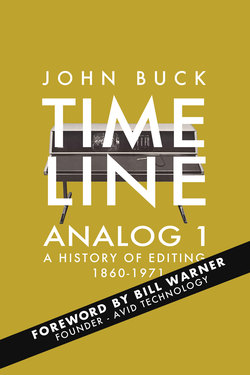Читать книгу Timeline Analog 1 - John Buck - Страница 3
На сайте Литреса книга снята с продажи.
Preface
ОглавлениеI set out on this journey after a discussion with Boris Yamnitsky, who had just acquired Media 100 from bankruptcy. I wanted him to succeed despite the gloomy prognosis but I urged him to dump the name of the company and re-brand it.
As a Media 100 editor turned Media 100 post suite owner, I felt that the brand no longer carried the currency that it once did. A new generation of editors cared little for history. “Start afresh, Boris”, I told him.
He replied, “I can't imagine any arguments for changing it”.
We exchanged emails debating the merits of product and brand. I wondered if other editing companies had shone so brightly and faded as fast that I could draw a lesson from, then share it with Boris. As a starting point I looked at the editing systems that I had used in my career. Names like Ampex, Sony, Bosch and CMX. Where had they gone?
I scanned my local library for a comprehensive book about editing equipment history to find answers but I found none. I dug around more, but only found 'how to' film editing books. There was a dearth of information on electronic editing, especially its origins. My casual conversation was now a niggling annoyance.
Curiosity soon had me searching for the story of Avid and EMC, CMX, Montage, Digital F/X and so on. But of course there wasn't such a book just a few breadcrumbs of information.
I found two key names listed in the U.S Patent Office register. Adrian Ettlinger and William Warner. Maybe they could help. One had created something called the CBS RAVE, and the other, Avid.
They graciously took my phone calls, retold stories of electronic editing’s rich history, and connected me with lesser known individuals who had created the tools we use today.
Adrian and Bill not only helped, but they actively encouraged me. Bill made time to talk, linked me to others and poured me coffee in his kitchen. Adrian braved the wet streets of Manhattan to tell me, over lunch at the Chiam, about a remarkable period of innovation.
My part-time quest changed when editor and Timeline contributors Jack Calaway, Larry Seehorn and Art Schneider passed away. Art made major contributions to editing, both film and electronic, yet his efforts like so many others had gone largely unheralded.
Jack and Larry had helped define the electronic platform for editing. To make sense of their work and so much more, I listened to former Xerox scientist David Canfield Smith who told me: “In any revolution, technological or otherwise, there are interesting characters. In fact, the characters often are the story”.
Ironically, to me at least, the man who had started me on this journey was typical of David’s observation. Boris Yamnitsky landed a part time programming job at Data Translation on the Media 100 digital editing system. After a successful launch he left and took a full time job at Pacer Software only to have it sold from underneath him. Yamnitsky was jobless when a friend convinced him to write a DVE program for editing systems, which became the hugely popular Boris FX.
Boris’ story could have ended there, however with the fruits of his success, he bought a bankrupt Media 100 and reinvented it for a new audience.
His story is this book’s repeating narrative.
A book that zig zags from people to places, within companies, across continents as editing is invented and refined across 100 years.
